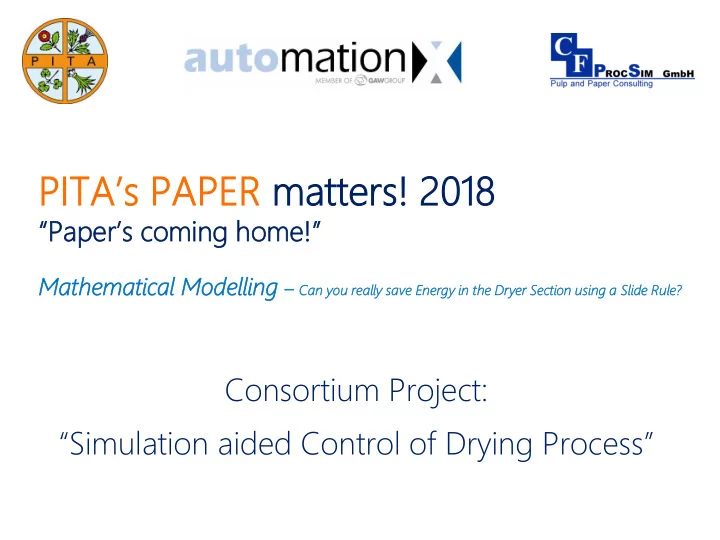

PITA’s PAPER matters! tters! 2018 18 “Paper’s coming home!” Mathem hematica atical l Modelli elling g – Can you u real ally save Ener nergy y in the he Drye yer r Sect ction n using ng a S Slide de Rule? Consortium Project: “Simulation aided Control of D rying Process” www.automationX.com
80% 80% of heat energy in a paper Mills is used by paper drying! Enough h to searc rch for improvem rovements! ents! The trials made by UK universities Manchester and Cambridge as well as Perceptive Engineering Ltd (2011) show realistic potential of reducing the energy used in papermaking by at least st 20% (presented at TAPPI PaperCon USA 2011) Similar potential has been confirmed by previous IEEA funded study (conducted in 2010). Also the trials made by AutomatioX and CF Procsim and published in “Paper T echnology” show high potential for energy reduction in paper making (also presented at TAPPI PaperCon USA 2014). www.automationX.com 2
10 % of heat energy reduction, what does it means? A paper mill with annual production of 200.000 tons will save around 40.000 tons LP steam. This represents approximately 25 GWh/y, which corresponds to the heating ting for 2000 standar dard d family ily houses. s. This s decreas reases es operatio rational nal costs ts by at leas ast £ 1milli lion www.automationX.com 3
Evidence to date shows there are a good prospects of reducing the energy in: Press section 5-6% => £k 500 Heat recovery system 4-5% => £k 400 Drying section 3-4% => £k 300 Based on annual production 200.000 tons www.automationX.com 4
How could the energy be reduced ? Key information from process! The mills are equipped with 3 steam flow meters, if at all No online information about dryness after press section Not enough information about air in PM hood Flexible, fast and precise control software! control reactions inflexible and unwieldy. Continuous observing of equipment efficiencies! No information about equipment efficiencies at all www.automationX.com 5
Conclusion of research work done at Perceptive Engineering Ltd and Universities of Manchester and Cambridge How to reduce energy? www.automationX.com 6
First methodology point: Model the machine as a multivariable process! Simul ulat ation on of d dewate atering ing and drying ing processes esses Individual Equipment Models Equipment T echnical Parameters Paper Machine Model Physical Process Equations Measured Process Data Model Validation www.automationX.com 7
Innovative control technology is based on two nearly identical processes (real and virtual) running in parallel. This technology enables to derive so far not available and difficult-to-measure new process values Virtual parallel new Paper simulated derived Machine values values Control system set points Real measured Paper values Machine www.automationX.com 8
Second methodology point: Use this model to design a multivariable model predictive controller! The control technology is based on new software architecture eDRY – Simulation aided control Virtual Paper Optimizing functions Machine Existing Control System Real Set Points Measurements Paper www.automationX.com Machine 9
Third methodology point: Run the controller with powerful real-time optimization functionality! Efficiency of press section as a function of web dryness after press. water removed removed water in dryer water steam removed in saving steam box more drying ? steam loss ! www.automationX.com steam consumption kg/s 10
Efficiency of heat recovery as a function of dew point in the PM hood. Exhaust air humidity steam consumption in PM hood dew point efficient working point working steam point loss ! www.automationX.com Fresh air flow m3/h 11
Real-time Optimization Functions for Press Section New functions: Online monitoring of the efficiency of press section Online monitoring of the web dryness after press section Control of the steam box efficiency Optimized control of the felt cleaning functions Potential for energy reduction 5-6% www.automationX.com 12
Real-time Optimization Functions for Drying Section Optimized functions: Fast control of the steam pressure for all steam cylinder groups Fast start-up after break Fast grade change Precision control of the paper final dryness New functions: Monitoring of the cylinder shell temperature Optimized control of the first and last cylinder shell temperature Potential for energy reduction 3-4% www.automationX.com 13
Real-time Optimization Functions for Heat Recovery Optimized functions: Grade dependent control of the exhaust air moisture Grade dependent heating of the fresh air New functions: Monitoring of the heat exchanger efficiency Potential for energy reduction 4-5% www.automationX.com 14
Technology pre-screening by Carbon Trust “You are welcome to tell potential partners that your technology solution has been "pre-screened" by the IEEA team, and that we believe that it is likely to be eligible for the IEEA and suitable for a full application, with good support from an industrial partner.” IEEA team m 24.05. 5.20 2018 18 www.automationX.com 16
PITA’s PAPER matte tters! rs! 2018 18 “Paper’s coming home!” Mathem hematica atical l Modelli elling g – Can you u real ally save Ener nergy y in the he Drye yer r Sect ction n using ng a S Slide de Rule? Hardl ardly, , but t surely ely you will lose at least £ 1 1 million once a y year Thank ank you ou for or you our r at atten ention tion www.automationX.com
Recommend
More recommend